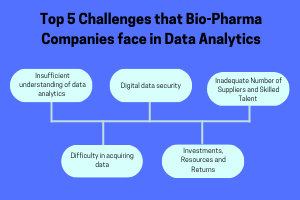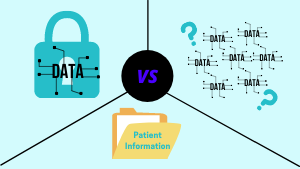Biopharma companies run on data analytics.
The degree of a company’s success is marked by its ability to integrate data analytics into its framework. Patent expirations, increased stringency of regulatory bodies, and large investments in drug development pose the biggest threats to the biopharma industry today. Data analytics is the only cost-effective way to manage them. Although it is essential, the lack of awareness surrounding it restricts its effective integration.

1. Insufficient Understanding of Data Analytics
The biopharma industry seems to lag behind in adopting data analytics. Restricted access to data is partially responsible for this. However, the most significant contributor is uncertainty and lack of awareness about data analytics. Change is often met with feelings of confusion and anxiety. Hence, companies may find themselves unable to leave the past behind.

Data analytics integration requires the latest technology and in-depth knowledge. Without these, companies will end up wasting necessary resources. Therefore, managers must encourage awareness about data analytics. They can garner organizational support by introducing interactive workshops and seminars.
2. Difficulty in Acquiring Data
Biopharma companies face difficulty in accessing data for 1 of 2 reasons – either there is too much unreliable information or too little useful data.
The biopharmaceutical industry acquires information from numerous data points. As a result, it increases their chance of accessing large bulks of unreliable data. Since this industry is tasked with providing personalized care for clients, they need access to specific data. However, these may not be available due to several factors. Typically, these range from confidentiality policies of patient information to ambiguous data ownership.

In India, much of the data on patient records are still paper-based. Furthermore, a study found that these account for unnecessary “ambiguities” caused by illegible handwriting. This can be addressed by transforming paper records into digital ones. Consequently, people would have better accessibility to updated patient histories.
3. Digital Data Security and Data Analytics
Biopharma companies deal with high-value data like Personal Health Information. Consequently, it is extremely valuable to black markets. They sell for thousands of dollars! They make the perfect concoction for attracting security threats and data breaches. For instance, high-profile companies like Lupin and Dr Reddy’s Laboratories have faced rampant cybersecurity breaches. Cyber-attacks, outdated security measures, and lack of data awareness among the management are all reasons behind ineffective cybersecurity. Therefore, integrating data analytics now is more important than ever before!

Legal acts can help biopharma companies contain these issues. HIPAA has become more stringent about data security now. As a result, organizations need to include security measures such as up-to-date anti-virus software and encryption of important data.
4. Investment, Resources, and Returns
Data analytics remains largely unexplored because of the scepticism around its promised revenues. Specifically, its mandatory technological aspects, cloud systems, and efficient operators require significant investment.

Therefore, companies are often reluctant to place all their eggs in the data analytics basket. This uncertainty may cause some companies to end up investing in software that might not satisfy their needs. As a result, they’ll end up spending much more – and losing much more – than another company that may have invested a larger amount the first time in the right analytics technology. Nevertheless, there are other solutions. For instance, resorting to optimized algorithms and data lakes are cost-effective options for integrating hybrid solutions in data storage infrastructure.
5. Inadequate Number of Suppliers and Skilled Talent in the field of Data Analytics
Lack of relevant skilled talent has also fuelled the biopharma’s inability to adapt to data analytics. Data is only as useful as its interpretation. Additionally, the biopharma sector is now forced to compete with other industries for trained experts with this expertise.

Where do we go from here?
“The biopharmaceutical sector is the fastest-growing part of the pharma industry, representing global revenues of $163 billion… and growing fast.” – Marison and Levison
The biopharma industry’s projected growth is promising. However, to turn this prediction into reality, the industry needs to increase its focus on cost-effective methods of drug discovery, development, and sales. Data analytics provides the only way forward. It determines which companies will be able to adapt to the latest technology. Consequently, it’ll ensure their dominance in the pharmaceutical industry.
